
مطالعه کیفی در مورد موانع شیردهی و تغذیه انحصاری با شیر مادر
1- Introduction
2- Methods
3- Results
4- Discussion
5- Conclusion
References
Introduction
Breastfeeding is the best way to provide nourishment to the child [1]. Breastfeeding helps the child to get all the nutrients that are needed for proper growth and development [1–3]. WHO recommends early initiation of breastfeeding, exclusive breastfeeding (EBF), and timely introduction of complementary feeding and continued breastfeeding for up to two years or beyond. EBF means that infants receive only breast milk during the frst six months without any additional food or fuid, not even water [1]. Te benefts of breastfeeding and EBF for the child, mother, and the community at large are well documented [3–6]. Although breastfeeding is a natural process, it is reported to be infuenced by diferent socio-cultural factors, habits, standards, and behaviors [7–10]. Literature shows that cultural traits related to breastfeeding may be harmful, harmless, or benefcial to the optimal breastfeeding practices [11]. Te harmful cultural traits reported to afect optimal breastfeeding practices include: giving prelacteal feeds, discarding colostrum and avoiding breastfeeding afer quarreling out of ‘fear of bad blood entering the milk which later may afect the child.’ Tese beliefs and practices are reported to lead to early cessation of EBF and breastfeeding in general [12–14]. In other settings, lack of support from family members or heath care professionals, peer pressure, mothers’ body image, the role of women in the reproduction process, and pressure to use artifcial feeding have led to early cessation of EBF and breastfeeding [9, 15, 16]. According to Daglas, culture afects the role of women with regard to breastfeeding and may create doubts to the mother’s natural ability to feed the baby resulting in early cessation of breastfeeding [15]. In Tanzania, breastfeeding is reported to be universal; about 97% of infants are breastfed and median duration is 21 months. Te trend of EBF up to six months at national level has shown increase from 49% in 2010 to 59% in 2015/15 [17, 18]. In the Kilimanjaro region, EBF is reported to be rarely practiced [19]. Diferent quantitative studies have reported the factors that infuence the practice of EBF in the region; the factors include advice on breastfeeding during pregnancy and afer delivery, child age, and alcohol intake. However, limited qualitative studies have explored mother’s experiences regarding the practice of EBF and cultural traits that may infuence EBF. According to Bazzamo and colleagues, culture plays a big role on breastfeeding practices of a given community [20]. In this article culture refers to the context of infant feeding in this community. As the cultural infuences may also vary from one setting to another, there was a need to explore the social and cultural infuences on the practice of EBF and breastfeeding in the Kilimanjaro region. Te fndings from this study can give a picture of facilitators and barriers that afect the practice of EBF. Te understanding of the facilitators and barriers is important for better planning of interventions that can help mothers adhere to the WHO recommendations for exclusive breastfeeding and breastfeeding practices.
